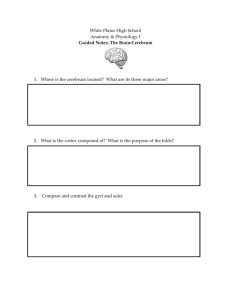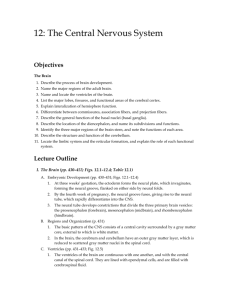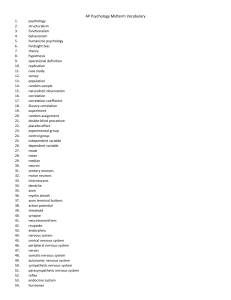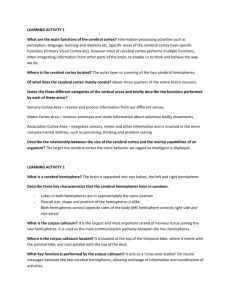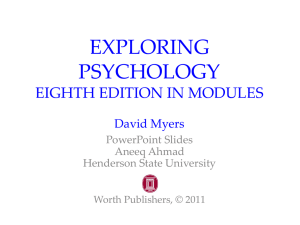Theoretical Approach to the Overall Control of the Nervous System
advertisement
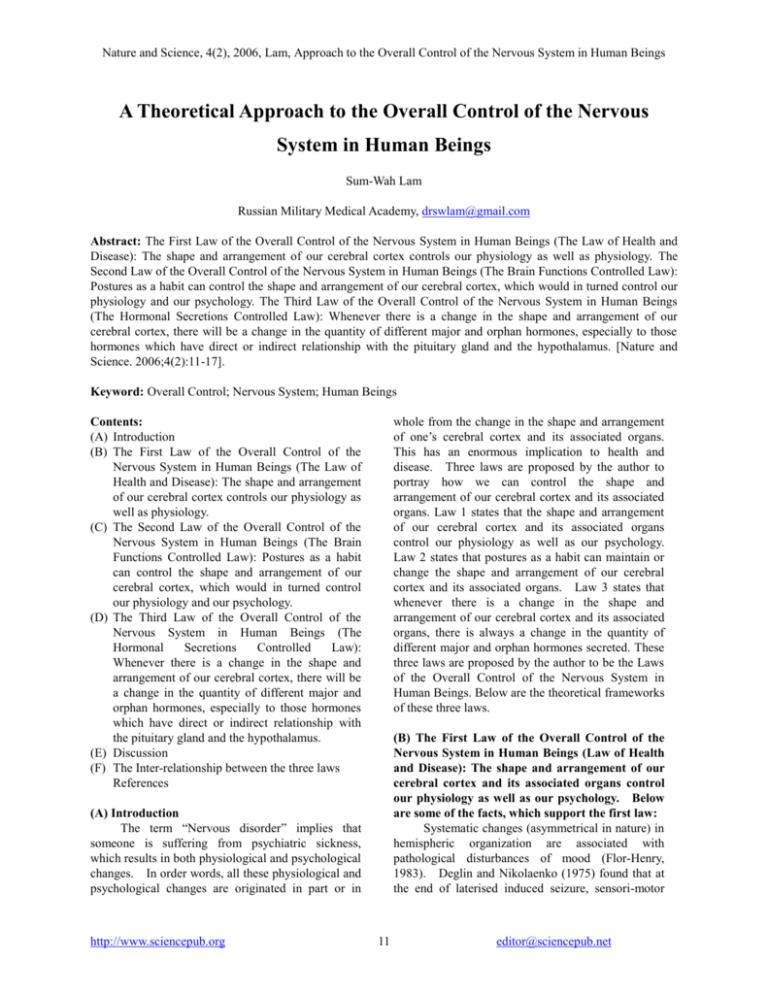
Nature and Science, 4(2), 2006, Lam, Approach to the Overall Control of the Nervous System in Human Beings A Theoretical Approach to the Overall Control of the Nervous System in Human Beings Sum-Wah Lam Russian Military Medical Academy, drswlam@gmail.com Abstract: The First Law of the Overall Control of the Nervous System in Human Beings (The Law of Health and Disease): The shape and arrangement of our cerebral cortex controls our physiology as well as physiology. The Second Law of the Overall Control of the Nervous System in Human Beings (The Brain Functions Controlled Law): Postures as a habit can control the shape and arrangement of our cerebral cortex, which would in turned control our physiology and our psychology. The Third Law of the Overall Control of the Nervous System in Human Beings (The Hormonal Secretions Controlled Law): Whenever there is a change in the shape and arrangement of our cerebral cortex, there will be a change in the quantity of different major and orphan hormones, especially to those hormones which have direct or indirect relationship with the pituitary gland and the hypothalamus. [Nature and Science. 2006;4(2):11-17]. Keyword: Overall Control; Nervous System; Human Beings Contents: (A) Introduction (B) The First Law of the Overall Control of the Nervous System in Human Beings (The Law of Health and Disease): The shape and arrangement of our cerebral cortex controls our physiology as well as physiology. (C) The Second Law of the Overall Control of the Nervous System in Human Beings (The Brain Functions Controlled Law): Postures as a habit can control the shape and arrangement of our cerebral cortex, which would in turned control our physiology and our psychology. (D) The Third Law of the Overall Control of the Nervous System in Human Beings (The Hormonal Secretions Controlled Law): Whenever there is a change in the shape and arrangement of our cerebral cortex, there will be a change in the quantity of different major and orphan hormones, especially to those hormones which have direct or indirect relationship with the pituitary gland and the hypothalamus. (E) Discussion (F) The Inter-relationship between the three laws References whole from the change in the shape and arrangement of one’s cerebral cortex and its associated organs. This has an enormous implication to health and disease. Three laws are proposed by the author to portray how we can control the shape and arrangement of our cerebral cortex and its associated organs. Law 1 states that the shape and arrangement of our cerebral cortex and its associated organs control our physiology as well as our psychology. Law 2 states that postures as a habit can maintain or change the shape and arrangement of our cerebral cortex and its associated organs. Law 3 states that whenever there is a change in the shape and arrangement of our cerebral cortex and its associated organs, there is always a change in the quantity of different major and orphan hormones secreted. These three laws are proposed by the author to be the Laws of the Overall Control of the Nervous System in Human Beings. Below are the theoretical frameworks of these three laws. (B) The First Law of the Overall Control of the Nervous System in Human Beings (Law of Health and Disease): The shape and arrangement of our cerebral cortex and its associated organs control our physiology as well as our psychology. Below are some of the facts, which support the first law: Systematic changes (asymmetrical in nature) in hemispheric organization are associated with pathological disturbances of mood (Flor-Henry, 1983). Deglin and Nikolaenko (1975) found that at the end of laterised induced seizure, sensori-motor (A) Introduction The term “Nervous disorder” implies that someone is suffering from psychiatric sickness, which results in both physiological and psychological changes. In order words, all these physiological and psychological changes are originated in part or in http://www.sciencepub.org 11 editor@sciencepub.net Nature and Science, 4(2), 2006, Lam, Approach to the Overall Control of the Nervous System in Human Beings cortical functions are transiently depressed. Laterization to the dominant hemisphere was produced profound intellectual retardation while laterization to non-dominant hemisphere lead to distinct intensification of emotional manifestations. Golden et al (1980) found that CT scan showed that the density of left hemisphere was greater than that of the right for a number of chronic schizophrenics. Sowell ER, Levitt J, Thompson P.M., Holmes CJ, et al. (2000) found brain abnormalities in MRI in mapping of the cerebral cortex and its associated organs). Niemann K., Hammers A., Coenen VA, Thron A., and Klosterkotter J. (2000) demonstrated that a smaller left hippocampus and left temporal horn in schizophrenic patients. Gur RE, Turetsky BI, Cowell PE, Finkelman C., Maany V., et al., (2000) found ventricular enlargement in schizophrenics. Crespo-Facorro B., Kim J., Andreasen NC, O’Leary DS, and Magnotta V (2000) showed there were regional frontal abnormalities in schizophrenia patients. Flashman LA, McAllister TW, Andreasen NC, and Saykin AJ (2000) found there was a smaller brain size associated with schizophrenics. Garver DL, Nair TR, Christensen JD, Holcomb JA, and Kingsbury, SJ (2000) demonstrated that there was instability in brain and ventricle for psychotic patients. Hirayasu Y, Shenton ME, Salisbury DF, and McCarley RW (2000) conducted a study on the hippocampal and superior temporal gyrus volume on schizophrenics and found they are different from normal subjects. Sanfilipo M, Lafargue T., Rusinek H, Arena L, Loneragan C, Lautin A, Lautin A, and Feiner D, et.al. (2000) found there were volumetric differences in the measurement of the frontal and temporal lobe regions in schizophrenics. Downhill JE, Buchsbaum MS, Wei T, Spiegel-Cohen J., Hazlett EA, Haznedar MM, Silverman J, and Siever LJ, (2000) showed that there were difference in the shape and size of the corpus callosum in schizophrenics. These are some of the findings on the relationship between the shape and arrangement of the cerebral cortex and its associated organs, and schizophrenics. Findings on the relationship between the shape and arrangement of patients with anxiety, mania, sexual disorder, and other psychopathology are many. In fact, Sowell ER, Toga AW, and Asarnow R (2000) did a literature review on the abnormalities in shape and arrangement of the cerebral cortex and its associated organs as demonstrated by magnetic resonance images. All these demonstrate that the cause of physiological and psychological disorders is rooted in the change in shape and arrangement of the cerebral cortex and its associated organs. Therefore, if we http://www.sciencepub.org can control the shape and arrangement of different parts of the cerebral cortex and its associated organs, we can control our physiology as well as our psychology. (C) The Second Law of the Overall Control of the Nervous System Human Beings (The Brain Functions Controlled Law): Postures as a habit, through tension and relaxation of our voluntary muscles, can maintain or change the shape and arrangement of our cerebral cortex, which would mean postures as a habit, can control our physiology as well as our psychology (Our voluntary muscular system controls the shape and arrangement of our cerebral cortex). Below are some of the facts, which support the second law: 1. Theories on therapeutic exercise contain much information on the relationship between exercise and therapy on certain diseases. As a result, exercise prescription is possible (Oshida Y, 2000; Kimura Y, and Iwasaka T, 2000; Sunami Y, Kiyonaga A, and Tanaka H, 2000; van der Velde G, and Mierau D, 2000; Phillips B.A., and Mastaglia FL, 2000; Kimura Y, 2000; Babyak M, Blumenthal J.A., Herman S, et.al., 2000; van Tulder M, Malmivaara A., Esmail R., and Koes B, 2000). During the process of exercise therapy, certain muscles are relaxed or at tension repeatedly. Therapy is possible because the voluntary muscular system controls the shape and arrangement of the cerebral cortex and hence can control the functions of the nervous system. 2. Yoga exercise is a well-established discipline, which has a very long history. Practitioners of the Yoga Exercise can maintain both their mind and body healthy, through certain postures as a habit. For many people with physiological or psychological defects, Yoga exercise provides a means of therapy (Kamei T, Toriumi Y, Ohno S, et.al, 2000; Tooley G.A, Armstrong SM, Norman TR, and Sali A, 2000; Bera TK, Gore MM, and Oak JP, 1998; Raghuraj P, Ramakrishnan AG, Nagendra HR, and Telles S, 1998; Murugesan R, Govindarajulu N, and Bera TK, 2000; Ramaratam S, and Sridharan K, 2000; Hudson S, 1998; Farrell SJ, Ross AD, and Sehgal KV, 1999; Gotter AC, 1999; and Singh R, 1999). This is possible because Yoga exercise can change the shape and arrangement of one’s cerebral cortex and hence can change one’s physiology and psychology, which can be used as a means of therapy. 3. Dunkell’s Theory (1977) on sleep postures as a habit has portrayed that there is a closed relationship between sleep postures and personality. This is only possible if a particular type 12 editor@sciencepub.net Nature and Science, 4(2), 2006, Lam, Approach to the Overall Control of the Nervous System in Human Beings of sleep posture will lead to a particular kind of shape and arrangement of one’s cerebral cortex. It is recorded in ancient Chinese sex books that different postures as a habit in the process of sexual intercourse provide means of therapy to certain diseases. People who practice such postures can become healthier (Wilson G, 1989; and, Stanway A, 1988). 4. It is known that the body language, the postures of sitting and walking, reflects our psychology and physiology (Pell AR, 1989; Leiber B, 1992; Kurz C, 1981; Russell RL and Stiles WB, 1979; Babic R, Green E, Bessineton JC, and Baron JB, 1978; Bijeliac-Babic R., 1978; Lundgren BF, 1994). It is also known that improper postures will result in chronic disease, for example, low back pain (Hartvigsen J, Leboeuf-Yde C, Lings S, and Corder EH, 2002; Clark AJ, 1996; Kauppila LI, 1996; Chilvers CD, Parker AH, and Guillen G, 1996). The above phenomena can be explained by saying that our postures are controlled by the shape and arrangement of our cerebral cortex and the voluntary muscular system controls the shape and arrangement of our cerebral cortex. 5. Alexander Technique also provides means of therapy to certain diseases by having certain postures as a habit. This involves particular types of posture, which is only possible if the voluntary muscles control the shape and arrangement of the cerebral cortex and hence can change the physiology and psychology of the practitioner (Gelb M, 1981; Huxley, 1940; Huxley, 1986; Jeffers, S, 1988; Barlow W, 1984; Maisel E, 1974; Lewis D, 1986; Alexander F.M., 1987; and Hayne, CR, 1987). Toriola AL, and Dada OA, 1986; Ronkainen HR, Pakarinen AJ, Kauppila AJ, 1986; Houmard JA, Costill DL, Mitchell JB, Park SH, Fink WJ, and burns JM, 1990; Mathur RS, Neff MR, Landgrebe SC, et.al., 1986), to quote a few. (E) Discussion 1. How our physiology and psychology are controlled? CT and MRI scan films show that many serious psychiatric sicknesses show peculiar patterns of shape and arrangement with the cerebral cortex and its associated organs. These indicate that the shape and arrangement of our cerebral cortex and its associated organs are relevant to our physiology as well as psychology. In fact, numerous diseases, which etiologies are unknown at present, for example, all types of hormonal diseases, such as diabetes mellitus, thyrotoxicosis, various kinds of cancer, and many other benign and malign diseases are originated from having problems with the shape and arrangement of our cerebral cortex and its associated organs. The mechanism in controlling one’s disease and well-being is that when the geometric shape of some convolutions in the cerebral cortex change, there are always a change in the degree of one’s physiological and psychological variables. By this mechanism, physiological and psychological variables can shift from one extreme to another. This explains how homeostasis can be disturbed and maintained, i.e. depending on the shape and arrangement of one’s cerebral cortex and its associated organs. The first law of the Overall Control of the Nervous System in Human Beings explains the causes of numerous diseases which have no answers at the moment, such as various kinds of cancer, various kinds of heart diseases, schizophrenia and other psychiatric sicknesses, which the diseases causes are unknown. All human physiology and psychology are controlled by the shape and arrangement of their cerebral cortex and its associated organs. (D) The third law of the Overall Control of the Nervous System in Human Beings (The Hormonal Secretions Controlled Law): Whenever there is a change in posture as a habit, which involves voluntary muscles, there is always associated with a change in the quantity of endocrine secretions, especially to those hormones which have direct or indirect relationship with the pituitary gland and the hypothalamus. Below are some of the facts: Postures as a habit during different physical activities and rest can alter the quantity of hormonal secretions (Brooke-Wavell K, Prelevic GM, Bakridan C, and Ginsburg J, 2001; McMahon M and Palmer RM, 1985; Moreau KL, Degarmo R, Langley J, et.al., 2001; Wheeler GD, Wall SR, Belcastro AN, and Cumming DC, 1984; Heitkamp HC, Huber W, and Scheib K, 1996; Bunt JC, Boileau RA, Bahr JM, and Nelson RA, 1986; Cumming DC, Brunsting LA 3 rd, Strich G, Ries AL, and Rebar RW, 1986; Mathur DN, http://www.sciencepub.org 2. How to control the shape and arrangement of our cerebral cortex, so as to control our physiology as well as our psychology? If the author’s first postulate is right, how to control the shape and arrangement of the human cerebral cortex will come next so as to solve physiological and psychological problems. If we can control the shape and arrangement of our cerebral cortex and its associated organs, we can control most aspects of our physiology and psychology. Law two of the Overall Control of the Nervous System in 13 editor@sciencepub.net Nature and Science, 4(2), 2006, Lam, Approach to the Overall Control of the Nervous System in Human Beings Human Beings portrays how our physiology and psychology can be controlled. In fact, the shape and arrangement of our cerebral cortex and its associated organs are controlled by our voluntary muscular system, i.e. by having postures as a habit. In fact, our ancestors have developed many methods to control the shape and arrangement of our cerebral cortex, though they did not know why they work and could not explain them on scientific grounds, such as postures as a habit in exercise, sleep, sexual intercourse, sitting, walking, or any kind of sports or device which voluntary muscular movements or postures as a habit are involved. In fact, all known cases of malign and benign diseases that can be cured without having any known medical treatment must have some changes in the shape and arrangement of his or her cerebral cortex and its associated organs to make him or her healthy again by chance or by accident. These cases are not miracles. In addition, by analyzing one’s different postures it is possible to know his/her physiology or psychology, which is useful in diagnosis or prognosis of certain physical and mental diseases. Furthermore, it is possible to tell one’s physiology and psychology at different times by analyzing his/her handwriting at different stages of his/her life. The author also found that musculature on our face, the shape of the eye brows and the lines on our hands change as a result of changing in habits of certain postures in different times of our life which reflect a change in our psychology and physiology. There are many ways to prove that our voluntary muscular system controls functions of the brain. One of the immediate consequence is that decussation of nerve fibers in the brain stem can be interpreted. It usually needs a signal from the cerebral cortex to execute a voluntary movement. It is also known that the left-brain controls the right side of the muscular system, and vice versa. In fact, when a signal is executed from the left-brain for a voluntary movement on the right side, the muscles on the right side will exert a signal to the right brain so as to set a balance on the left side of the muscular system. The reverse is also true, which is essential in maintaining homeostasis. This can be easily proved in a laboratory where facilities for measurement of electrical activities are available. It is recorded clinically that many diseases, including the communicable diseases, tuberculosis, and the non-communicable diseases, various kinds of cancer, can be cured without the intake of medicine or having other known medical treatments. Scientists should not believe in miracles. The mechanism on these is simple, as there must be some http://www.sciencepub.org changes on the shape and arrangement of the patients’ cerebral cortex for them to get recovered. In fact, numerous malignant and benign diseases are given arisen because there were changes in the shape and arrangement of the cerebral cortex. It is also under the same mechanism which people with malignant and benign diseases can be cured without having medical treatments. Laws of the Overall Control of the Nervous System explain the etiology of many non-communicable diseases and some communicable diseases. They explain how many psychiatric sicknesses are given rise, including epilepsy, schizophrenia, affective disorder, hysteria, obsessional states, and finally sexual disorder. They explain how we can get cured in many sicknesses without the intake of medicine and receiving any known medical treatment. They also explain how physiological brain-washing is possible. By the application of these hypotheses mental giants such as Einstein and other great thinkers can be produced in a sleep laboratory. Dunkell (1977) found that people with different sleep postures have different personality. But how about if we ask people to change their sleeping positions as a habit? Shall we expect a change in his/her personality as well? I believe and support the statement that there will be a change in personality from the first type to the second type. If not, all information from Dunkell’s book will be invalid. Therefore, sleep postures as a habit can portray one’s tendency for different diseases. Budda did sleep in some particular position as a habit, and he was also famous for his ability to control his physiology and psychology. I believe that Budda was the first person, who knew some of the ways to control human physiology and psychology, by sleeping or sitting in some particular positions. My Laws can link up the gap between oriental and western medicine. I believe that Buddhism is a treasure source of information on how to control human physiology and psychology through different postures. Therefore, if we can control the shape and arrangement of one’s cerebral cortex, we can control his or her sicknesses. Unfortunately, no controlled experiment on this has been done and the author thinks a study on the relationship between shape and arrangement of the cerebral cortex and its associated organs, and psychopathological variables is necessary. In the coming few decades, scientists can devise means to alter or change patient’s shape and arrangement of their cerebral cortex and its 14 editor@sciencepub.net Nature and Science, 4(2), 2006, Lam, Approach to the Overall Control of the Nervous System in Human Beings associated organs by means of electrical methods, such as the Electro-convulsive Therapy, Yoga exercise, breathing exercise, chemical convulsants, or any voluntary movement which muscles are involved, so as to cure diseases. This is very important in the treatment of all kinds of sickness symptoms, no matter physical or psychological, mild or serious. 4. 5. 6. 7. 3. Effects on change in the shape and arrangement of our cerebral cortex on the quantity of hormonal secretions When there are changes in postures as habit, such as having a particular kind of sports, exercise, there are always changes in quantity of different hormonal secretions, as demonstrated by Law Three of the Overall Control of the Nervous System in Human Beings. One of the very factors how Yoga exercise is effective in controlling our physiology as well as our physiology is that Yoga exercise has profound influence on the quantity of different hormonal secretions. The shape of our skull is another factor, which can determine our physiology and psychology, as the shape and arrangement of our cerebral cortex always depends on the shape of our skull. As far as to healing diseases are concerned, we certainly can control our postures as a habit to deal with the benign and malignant diseases. 8. 9. 10. 11. 12. 13. (F) Inter-relationship between the three laws: The shape and arrangement of our cerebral cortex control our physiology and psychology (Law 1) and the shape and arrangement of our cerebral cortex in turn is controlled by our postures as a habit (Law 2). Postures as a habit controls our physiology and psychology, this is possible because the shape and arrangement of our cerebral cortex controls the secretions, in terms of quantity, of different major and orphan hormones (Law three). 14. 15. 16. Correspondence to: Sum-Wah Lam P.O. Box 806, Tuen Mun Central Post Office, Hong Kong SAR, China Telephone: (+852) 8119 8135; Fax: (+852) 3014 5724 E-mail: drswlam@gmail.com 17. 18. References: 1. 2. 3. 19. Aaronson, S.T., Siham, R., Biber, M.P and Hobson, J.A. (1982) Brain state and body position. Arch. Gen. Psychiatry, 1982, 39, 330-5. Alexander FM (1932). The use of self. Dutton, New York. Babic R, Green E, Bessineton JC, and Baron JB (1978). http://www.sciencepub.org 20. 21. 15 Body language and tonic postural action. Agressologie. 1978; 19(B): 51-2. Barrow, W. (1984). The Alexander Principle. Arrow. Bera TK, Gore MM, and Oak JP (1998). Recovery from stress in two different postures and in Shavasana-a yogic relaxation posture. Indian J Physiol Pharmacol. 1998;42(4); 473-8. Berbard, T. Hatha Yoga. London: Rider, 1968 Bijeljac-Babic R. (1978). Body language and communication. Agressologie. 1978; 19(6):349-51. Brooke-Wavell K, Prelevic GM, Bakridan C, and Ginsburg J. (2001). Effects of physical activity and menopausal hormone replacement therapy on postural stability in postmenopausal women-a cross sectional study. Maturitas 2001 Jan 31; 37(3):167-72. Bunt JC, Boileau RA, Bahr JM, and Nelson RA. (1986). Sex and training differences in human growth hormone levels during prolonged exercise. J App Physiol 1986 Nov; 61(5): 1796-801. Cartwright, R.D. Effect of sleep position on sleep apnea severity. Sleep. New York, Raven Press, 1984. Chilvers CD, Parker AH, and Guillen G. (1996). Low back pain. NZ Med J. 1996 Aug 23; 109(1028):324. Clark AJ (1996). Back pain without apparent cause. CMAJ. 1996 Oct 1: 155(7):861-2. Crespo-Facorro B, Kim J, Andreasen NC, O’Leary DS, and Magnotta V. (2000). Regional frontal abnormalities in schizophrenia: a quantitative gray matter vs. and cortical surface size study. Biol Psychiatry. 2000. July 15; 48(2):110-9. Cumming DC, Brunsting LA 3rd, Strich G, Ries AL, and Rebar RW. (1986). Reproductive hormone increases in response to acute exercise in men. Med Sci Sports Exerc 1986 Aug; 18(4): 369-73. Deglin V.L., Nikolaenko N.N. (1975) Role of the dominant hemisphere in the regulation of emotion states. Human Physiology. 1975: 1(3). De Koninck J., Gagnon P., and Lallier. Sleep positions in the young adult and their relationship with subjective quality of sleep. Sleep. New York, Raven Press, 1983. Domino G. and Bohn S.A. Hynagogic exploration: Sleep positions and personality. J. Clin. Psychol. 1980:36:760-2. Downhill JE, Buchsbaum MS, Wei T, Spiegel-Cohen J, Hazlett EA, Haznedar MM, Silverman J, and Siever IJ. (2000). Shape and size of the corpus callosum in schizophrenia and schizotypal personality disorder. Schizophr Res. 2000 May 5, 42(30: 193-208. Dunkell, S., Sleep positions. New York, William Morrow, 1977. Farrell SJ, Ross AD, and Sehgal KV (1999). Eastern movement therapies. Phys Med Rehabil. Clin N Am. 1999 Aug; 10(3): 617-29. Felson, B. Computerized Cranial Tomography. New York: Grune and Stratton, 1977. editor@sciencepub.net Nature and Science, 4(2), 2006, Lam, Approach to the Overall Control of the Nervous System in Human Beings 22. Flashman LA, McAllister TW, Andreasen NC, and Saykin AJ. (2000). Smaller brain size associated with unawareness of illness in patients with schizophrenia. Am J Psychiatry. 2000 Jul; 157(7): 1167-9. 23. Flor_Henry, Pierre. Cerebral basis of psychopathology. Bristol: John Wright. (1983). 24. Gelb, M (1981). Body learning: An introduction to the Alexander Technique. Aurum Press, 1981. 25. Golden, C.J., Graber B., Coffman J. et al (1980) Brain density deficits in chronic schizophrenia. Psychiatry Res. 1980. 26. Gotter AC (1999). Western movement therapies. Phys Med Rehabil Clin N Am. 1999 Aug; 10(3): 603-16. 27. Gur RRe, Turetsky Bi, Cowell PE, Finkelman C, Maany V, Grossman RI, Arnold SE, Bilker WB, and Gur RC. (2000). Temporolimbic volume reductions in schizophrenia. Arch Gen Psychiatry. 2000 Aug; 57(8): 769-75. 28. Hartvigen J, Leboeuf-Yde C, Lings S, and Corder EH (2002). Does sitting at work cause low back pain? Ugeskr Laeger, 2002 Feb 4; 164(6): 759-61. 29. Hayne C.R. (1987). Total back care. Dent. 30. Heithkamp HC, Huber W, and Scheib K. (1996). Beta-Endorphin and adrenocorticotrophin after incremental exercise and marathon running-female responses. Eur J App Physiol Occup Physiol 1996; 72(5-6): 417-24. 31. Hewitt, J. Teach yourself Yoga. London: English University Press, 1960. 32. Hirayasu Y, Shenton ME, Salisbury DF, and McCarley RW. (2000). Hippocampal and superior temporal gyrus volume in first-episode schizophrenia. Arch Gen Psychiatry. 2000 Jun; 57)6_’ 618-9. 33. Hobson, J.A., Spagna, T. & Malenka, R. Ethology of sleep with time-lapse photograph: Postural immobility and sleep cycle phase in man. Science, 1978, 201, 1251-3. 34. Houmard JA, Costill DL, Mitchell JB, Park SH, Fink WJ, and Burns JM (1990). Testosterone, cortisol, and creatine kinase levels in male distance runners during reduced training. Int J Sports Med 1990 Feb; 11(1):41-5. 35. Hudson S. (1998). Yoga aids in back pain. Aust Nurs J 1998 Apr; 5(9):27. 36. Huxley, A. (1940). Ends and means. Chatto and Windus 37. Huxley, A. (1986). Eyeless in Gaza. Grafton. 38. Jeffers, S. (1988). Feel the fear and do it anyway. Century. 39. Kamei T, Toriumi Y, Kimura H., et.al. (2000). Decrease in serum cortisol during Yoga exercise is correlated with alpha wave activation. Percept Mot Skills. 2000 Jun; 90(3 pt 1): 1027-32. 40. Kauppila LI. Studying low back pain. Spine. 1996 Feb 15; 21(4):527. 41. Kimura, Y. (2000). Exercise therapy for hypertension. Nippon Rinsho. 2000 Feb; 58 Suppl 2:56-9. 42. Kimura Y, and Iwasaka T. (2000). Complication of exercise therapy. Nippon Rinsho. 2000 Sep.58 Suppl: 226-8. 43. Kurokawa K, Nakamura K., Sumiyoshi T, Hagino H, http://www.sciencepub.org 44. 45. 46. 47. 48. 49. 50. 51. 52. 53. 54. 55. 56. 57. 58. 59. 60. 61. 16 Yotsutsuji T, Yamashita I,. Suzuki M., Matsui M, and Kurachi M. (2000) Ventricular enlargement in schizophrenia spectrum patients with prodromal symptoms of obsessive-compulsive disorder. Psychiatry Res. 2000 Aug 28; 99(2):83-91. Kurz C. (1981). Language and behaviour, two means of communication. Soins Psychiatr. 1981 Oct; (12):2. Leiber, B. (1992). Body language: ”Language to be seen”. Kinderkrankenschwester, 1992 Mar; 11(3):94-5. Lewis, D. (1986). The Alpha Plan. Methuen. Lundgren BF (1994). Your body language reveals you! Vardfacket. 1994 June 2; 18(10):4-6. Maisel E. (1974). The Alexander Technique: Essential writings of F.M. Alexander. Thames and Hudson. Mathur DN, Toriola AL, and Dada OA (1986). Serum cortisol and testosterone levels in conditioned male distance runners and non-athletes after maximal exercise. J Sports Med Phys Fitness 1986 Sep; 26(3): 245-50. Mathur RS, Neff MR, Landgrebe SC, Moody LO, Kirk RF, Gadsden RH Sr, and Rust PF. (1986). Time-related changes in the plasma concentrations of prolactin, gonadotropins, sex hormone-binding globulin, and certain steroid hormones in female runner after a long-distance race. Fertil Steril 1986 Dec: 46(6): 1067-70. McMahon M and Palmer RM (1985). Exercise and hypertension. Med Clin North Am 1985 Jan; 69(1):57-70. Moreau KL, Degarmo R, Langley J, McMahon C, Howley ET, Bassett DR, and Thompson DL (2001). Increasing daily walking lowers blood pressure in postmenopausal women. Med Sci Sports Exerc 2001 Nov; 33(11): 1825-31. Murugesan R, Govindarajulu N., and Bera T.K. (2000). Effect of selected yogic practices on the management of hypertension. Indian J Physiol Pharmacol 2000 Apr; 44(2): 207-10. Niemann K, Hammers A, Coenen VA, Thron A., and Klosterkotter J. (2000). Evidence of a smaller left hippocampus and left temporal horn in both patier first episode schizophrenias and normal control subjects. Psychiatry Res. 2000 Aug 28; 99(2): 93-110. Oshida, Y. (2000). Practice of exercise therapy for diabetes mellitus. Nippon Rinsho. 2000 Sep; 58 Suppl: 391-6. Pell AR (1989). Body language. Indiana Med. 1989 Sep; 82(9):749. Phillips BA, and Mastaglia FL (2000). Exercise therapy in patients with myopathy. Raghuraj P, Ramakrishnan AG, Nagendra HR, and Telles S. (1998). Effect of two selected yogic breathing techniques of heart rate variability. Indian J. Physiol Pharmacol. 1998 Oct; 42(4): 467-72. Ramaratnam S, and Sridharan K. (2000). Yoga for epilepsy. Cochrane Database Syst Rev. 2000; (2): CD001524. Review. Ronkainen HR, Pakarinen AJ, and Kauppila AJ (1986). Adrenocortical function of female endurance runners and joggers. Med Sci Sports Exerc 1986 Aug; 18(4):385-9. Russell RL and Stile WB. (1979). Categories for classifying editor@sciencepub.net Nature and Science, 4(2), 2006, Lam, Approach to the Overall Control of the Nervous System in Human Beings 62. 63. 64. 65. 66. 67. language in psychotherapy. Psychol Bull. 1979 Mar; 86(2):404-19. Singh R. (1999). Role of yogic exercises/meditation in aircrew stress management. Aviat Space Environ Med. 1999 Sep; 70(9):939. Sivananda, S. Practice of Yoga. Sivanandanagar, U.P. Ddivine Life Society, 1970. Sodee, D.B. Correlations in diagnostic imaging. New York: Appleton Century Crofts, 1979. Solis, H., Fernandez-Guardiala & Valverde, R. in “Neuropharmacologic and Neuroendocrine inter-relations of Human Sleep” in the Function of Sleep, New York: Academic Press, 1979. Sowell ER, Toga AW, and Asarnow R. (2000). Brain abnormalities observed in childhood-onset schizophrenia: a review of structural magnetic resonance imaging literature. Ment Retard Dev Disabil Res Rev. 2000; 6(3);180-5. Review. Sowell ER, Levitt J., Thompson PM, Holmes CJ, Blanton RE, Kornsand DS, Caplan R, McCracken J, Asarnow R, and Toga AW. Brain abnormalities in early-onset schizophrenia spectrum disorder observed statistical parametric mapping of structural magnetic resonance imaging of volume differences in brain structure. Am J Psychiatry. 2000 Sep; 157(9): 1475-84. http://www.sciencepub.org 68. Stanway, A. (1988). The loving touch. Barcelona: Guild Publishing. 69. Sunami Y, Kiyonaga A, and Tanaka H. (2000). The basic concept of exercise therapy. Nippon Rinsho. 2000 sep; 58 suppl:216-20. 70. Thomson, John A. An introduction to clinical endocrinology. New York: Churchill Living Stone, 1976. 71. Tooley GA, Armstrong SM, Norman TR, and Sali A (2000). Acute increases in night-time plasma melatonin levels following a period of meditation. Biol. Phychol. 2000 May; 53(1):69-78. 72. Van de Velde G, and Mierau D. (2000). The effect of exercise on percentile rank aerobic capacity, pain, and self-rate disability in patients with chronic low-back pain: a retrospective chart view. Arch Phys Med Rehabil. 2000. Nov; 81(11):1457-63. 73. Vivekananda, S. Raja Yoga, or conquering the internal nature. Calcutta: Advavita Ashrama, 1950. 74. Wheeler GD, Wall SR, Belcastro AN, and Cumming DC (1984). Reduced serum testosterone and prolactin levels in make distance runners. JAMA 1984 Jul 27; 252(4):514-6. 75. Wilson G. (1989). The sensual touch. London: Guild Publishing. 17 editor@sciencepub.net
